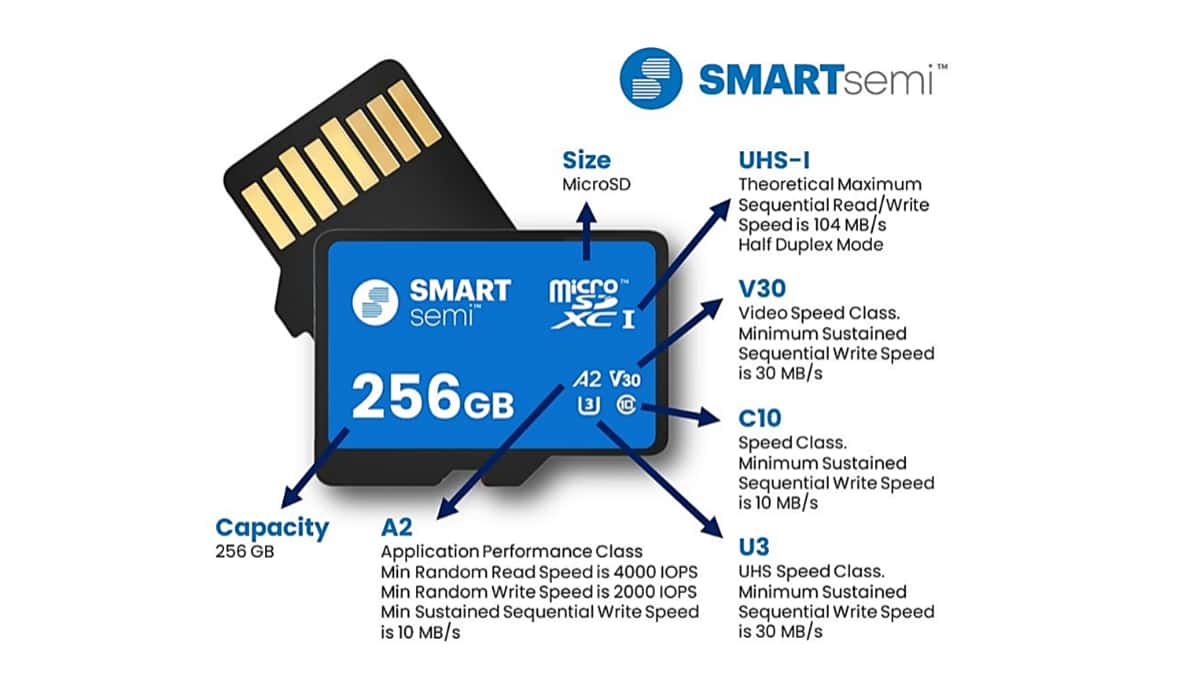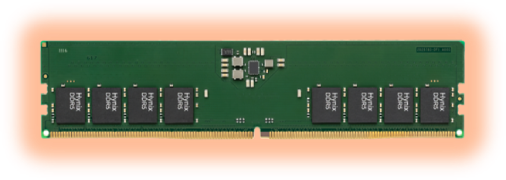SD Performance Standards

Secure Digital™ (SD) cards are a staple in the memory industry. The SD card is found in a plethora of industrial applications and is a popular storage media for consumers. Its popularity can be attributed to its flexibility, low power consumption, and small, portable form factor. SD cards can be used as removable or fixed drives and serve as data storage as well as boot drives. The main criteria for SD card selection for a specific application are physical size, capacity, and speed. Since it was founded in 2000, the SD Association (SDA) has developed and defined industry standards for SD cards. In this blog post, we’ll dive deeper into the different options and corresponding symbols to simplify the selection process for SD cards.
Physical Size
Over the years, different size formats of SD cards have been released, with microSD being the most popular one today. The standard SD card is 24 x 32 x 2.1 mm, while microSDs are about half that size in every direction at 11 x 15 x 1 mm. MicroSD cards can be inserted in standard SD card readers by means of an SD card adapter. In practice, large consumer products like laptops, digital cameras, and camcorders tend to have SD card slots, whereas smaller electronics like smartphones or VR headsets work with microSD.
Capacity
The capacity of the SD and microSD cards has grown from 128MB to multiple TB. The different tiers are labeled as:
- SD or SDSC (Secure Digital Standard Capacity): up to 2GB
- SDHC (Secure Digital High Capacity): >2GB to 32GB
- SDXC (Secure Digital eXtended Capacity): >32GB to 2TB
- SDUC (Secure Digital Ultra Capacity): >2TB to 128TB
Every card has its exact capacity listed on it. The main takeaway when it comes to selecting the right capacity is to make sure that the device you are using it with is compatible. SD cards are made backward compatible. However, older SD hosts are not always forward compatible, meaning newer SDHC and definitely SDXC may not work in an older SD host, while you can usually still use an older SD card in a newer SDXC host.

Speed
While size and capacity are easy to discern at first glance, the system to categorize the variety of read and write speeds is more complex. The read and write speeds depend on how data is accessed or stored, resulting in a sequential and random read/write speed. In general, reading data from the card is faster than writing data to it, and the sequential speed is higher than the random read/write speed, making cards ideal for images and video storage. The sequential read/write speed is expressed in MB/s (megabytes per second, not megabits!), while the unit for random read/write speed is IOPS (input-output access per second). For sequential read/write speed ratings, three speed classes were defined by the SDA: Speed Class (C), UHS Speed Class (U), and Video Speed Class (V). All these ratings convey the minimum sustained write speed. In other words, the card is able to continuously write data at this speed or faster. The sequential read speed will be higher. A separate Application Performance Rating (A) is used to categorize random read/write speed for SD/microSD.
The original system uses “Class”, abbreviated to C, followed by 2, 4, 6, or 10. By simply putting MB/s behind it, you know the minimum continuous write speed: 2MB/s, 4MB/s, 6MB/s, or 10MB/s. In today’s market, it is rare to come across an SD card that doesn’t have a C10 speed class rating.
As speed performance kept increasing with technological advancement a new standard was introduced, Ultra High Speed (UHS), represented by the numbers 1 or 3 inside the letter U and a Roman letter I, II, or III. U1 guarantees a minimum write speed of 10 MB/s, the equivalent of C10. U3 is 30 MB/s and is generally a minimum requirement for high-resolution video recording.
The Roman numbers indicate the bus configuration and a theoretical maximum data transfer rate. For UHS-I cards, the theoretical maximum speed for both reading and writing data is 104 MB/s. These SD/microSD cards have only one set of metal contacts that can be used to read or write, so the bus runs in Half Duplex mode – you can either read or write, but not simultaneously. UHS-II and III have two and three rows respectively, allowing them to run in Full Duplex mode. UHS-II can reach speeds up to 312 MB/s in Half Duplex and 156MB/s in Full Duplex. UHS-III’s maximum sequential read/write speed in Half Duplex mode is 624 MB/s or 312 MB/s in Full Duplex. Unlocking maximum speeds require the card and host to be rated the same. The two notations related to UHS are usually present on the SD/microSD card. For example, the combination of U3 with I as illustrated here, means that a minimum write speed of 30 MB/s is guaranteed, but the SD/microSD card can potentially reach a maximum read/write speed of 104 MB/s if used in a host that supports the UHS-I bus interface.

Video Speed
The evolution of video resolution to 8K and more sophisticated video recording features resulted in a new ranking: Video Speed Class. Video recording demands a higher minimum write speed so enough frames are captured for a smooth playback. The Video Speed Class uses the letter V with a number from 6 to 90 for the minimum continuous write speed in MB/s. The most common symbols on SD/microSD cards are V30, V60, and V90 since they indicate speeds beyond U3. UHS-I can only support Video Speed Classes up to V30. V60 and V90 work in UHS-II mode or faster. An additional requirement for the SD/microSD cards and hosts with a V-logo is that they support modern-day MLC NAND Flash technology.
Application Performance Class
The final classification on SD/microSD cards is A1 or A2, indicating the Application Performance Class. This ranking relates to the random read/write speed, while all the above speed classes categorized the sequential speed. The two classes, A1 and A2, are defined by a minimum random read and write speed and also have a minimum sustained sequential write speed of 10MB/s (V10). The Application Performance Class is important in devices that run applications and need to access data blocks scattered throughout the memory. Most cameras only need sequential access, so the A classification on the SD/microSD is less important.
Physical size, capacity, and speed are the three main characteristics when selecting SD/microSD cards. However, more is not always better. The best performance is reached when these parameters are matched between card and device/host. The least performant entity will determine the experience. Since speed and capacity come at a cost, selecting the right SD/microSD card guarantees the best value – and performance - for money. SMARTsemi recently expanded its product range with SD/microSD cards that are the perfect match for many long-life applications and equipment.

SMARTsemi is your supply chain partner for DRAM components, eMMC solutions, and SD/microSD Flash Memory Cards for long-life applications. With 20+ years of industry experience, we understand your challenges and have aligned our priorities with yours to simplify your memory chip supply chain for the long run. We know what you need before you need it. Get a jump start and request a sample today.







